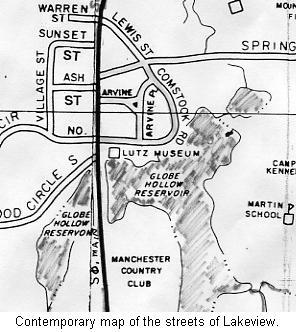Lakeview -- A Housing Development With Long-Term Appeal
By Susan Barlow
The Manchester Historical Society leads periodic walking tours of the Lakeview section of town. Participants often
express surprise that such an area exists right off South Main Street. They hadn't previously visited Arvine Place and
Comstock Road, the two principal streets of the 1920s subdivision. The charming houses and curving streets are enhanced by the old-fashioned grass triangles at the intersections.
 The "Lake" that the area overlooks is actually Globe Hollow Reservoir, with its pretty causeway that you can drive
along to get to the golf course, and beyond that into Glastonbury.
The "Lake" that the area overlooks is actually Globe Hollow Reservoir, with its pretty causeway that you can drive
along to get to the golf course, and beyond that into Glastonbury.
 Lakeview was "platted," in 1925, that is, the plat or map of proposed streets and house-lots was made. According to a
1998 Historic Resources Inventory (Connecticut Historical Commission), the development was considered part of the "growing
automobile suburbs, usually situated near the community's principal roads. During the 1920s and 1930s, many Manchester
residents occupied new homes in the 'Lakeview' subdivision, which had emerged as an enclave of large suburban homes situated
just north of the newly opened Manchester Country Club."
Lakeview was "platted," in 1925, that is, the plat or map of proposed streets and house-lots was made. According to a
1998 Historic Resources Inventory (Connecticut Historical Commission), the development was considered part of the "growing
automobile suburbs, usually situated near the community's principal roads. During the 1920s and 1930s, many Manchester
residents occupied new homes in the 'Lakeview' subdivision, which had emerged as an enclave of large suburban homes situated
just north of the newly opened Manchester Country Club."
Homeowners bought the lots and then built a variety of houses of "attractive types, including Colonial Revival, Dutch
Colonial, and Picturesque English Cottage examples." Architectural features include decorative brickwork, molded eaves and
cornices, wooden porch columns, and interesting window surrounds.
Restrictions
Lakeview's deeds had "restrictions," a common practice at the time. In the 1920s and 1930s, advertisements touted
"restricted home sites," ostensibly to protect new homeowners from neighbors who wanted to conduct commercial activities,
open a gas station, or build chicken coops in the backyard.
A Lakeview deed dated September 27, 1939, says, "No noxious or offensive trade shall be carried on upon said premises
objectionable to the neighborhood." To maintain the upper-middle-class atmosphere, the deed bans houses from sprawling too
close to the road, "No building shall be erected on said land whose front foundation line is less than 30 feet back from
the street line. Not more than one dwelling is to be constructed on this lot to cost less than $6500.00 and no dwelling is
to be erected to house more than one family." These clauses presaged Manchester's zoning regulations enacted in 1938, and
subdivision regulations, in 1943.
However, not all the restrictions were so innocuous, and couched in a "first offer" clause is a method of preventing
"undesirables" from purchasing house lots: "...provision that in case the said Grantee herein desires to sell the above
described land, they shall first offer the same for sale to other owners of lots in said 'Lakeview Tract.'" This was a
mechanism to approve or disapprove of potential purchasers, possibly discriminating against people of color or the "wrong"
religion or whatever the other owners might object to. Deeds such as this can be found in the archives of Town Hall, but
the "approval" restrictions have long since been found unconstitutional, and the "chicken coop" clauses have been
superseded by zoning and other regulations.
C. Elmore Watkins
 On the lower left of the Lakeview plat (see picture), is the inscription, "Property of C.E. & F.E. Watkins." Watkins is
a familiar name in Manchester: C. Elmore's father, Clarence Watkins, incorporated the Manchester Trust Company, served as
the town's First Selectman and as a State legislator, and constructed large buildings along Main Street. Clarence and his
brother Ernest started an undertaking business in 1874 and later took over the furniture department of the Cheney general
store. (It was not uncommon to combine the furniture and undertaking businesses -- another example is the North End's Apel
Opera House, where Conrad Apel also operated a saloon and auditorium for traveling vaudeville shows). Many local homes have
furniture purchased at Watkins Brothers Furniture store, formerly at 935 Main Street.
On the lower left of the Lakeview plat (see picture), is the inscription, "Property of C.E. & F.E. Watkins." Watkins is
a familiar name in Manchester: C. Elmore's father, Clarence Watkins, incorporated the Manchester Trust Company, served as
the town's First Selectman and as a State legislator, and constructed large buildings along Main Street. Clarence and his
brother Ernest started an undertaking business in 1874 and later took over the furniture department of the Cheney general
store. (It was not uncommon to combine the furniture and undertaking businesses -- another example is the North End's Apel
Opera House, where Conrad Apel also operated a saloon and auditorium for traveling vaudeville shows). Many local homes have
furniture purchased at Watkins Brothers Furniture store, formerly at 935 Main Street.
C. Elmore Watkins [1882-March 5, 1976], Clarence's son, joined his uncle, F.E., right after college to manage the many
aspects of the furniture business. In the 1923 book "Who's Who in Manchester, Connecticut," author Thomas J. Quish lauds C.
Elmore's work: "In 1920, the beautiful new store, recently voted in a nation-wide poll the finest small town furniture
store in the United States, was built under Mr. Watkins' personal direction. It was Mr. Watkins who suggested a hospital as
the proper memorial [to World War I veterans]. He was subsequently elected chairman of the Building Committee, overseeing
the construction of the hospital building, and later was made president of the Board of Trustees, which office he still
holds. Mr. Watkins is also a director of the Savings Bank of Manchester, president of the Life and Advent Union,
vice-president of the Tufts College of Connecticut, also a member of the University Club of Hartford and the Manchester
Country Club and Manchester Chamber of Commerce."
C.E. somehow found time to develop Lakeview, too. In laying out the plat, he and F.E. strove for an expansive, but
homey, subdivision.
On the other side of South Main Street, Watkins later developed the Lakewood Circle subdivision, but that's another
story for another time.
Ireanus Brown House
 Intermixed with the Lakeview development are older houses -- notably 211 South Main Street, the Comstock House, circa
1830-1840; and 189 South Main Street, circa 1752, the oldest standing house in Manchester. #189 is a handsome
gambrel-roofed house, whose original owner is not known and so it goes by the name of a later owner, Ireanus Brown
(1780-1873), supposedly a Colonel in the First Regiment of Connecticut infantry from 1822 to 1824. Former Town Historian
Herb Bengtson, 1913-2010, couldn't verify Brown's military rank and was reluctant to call him Colonel Brown. Also unauthenticated is
the Underground Railroad designation for the hidden compartment under the stairs, and it is not on the Connecticut Freedom Trail list. Ireanus Brown was one of the founders of
Manchester's Baptist church, which met at his house before they had a church building.
Intermixed with the Lakeview development are older houses -- notably 211 South Main Street, the Comstock House, circa
1830-1840; and 189 South Main Street, circa 1752, the oldest standing house in Manchester. #189 is a handsome
gambrel-roofed house, whose original owner is not known and so it goes by the name of a later owner, Ireanus Brown
(1780-1873), supposedly a Colonel in the First Regiment of Connecticut infantry from 1822 to 1824. Former Town Historian
Herb Bengtson, 1913-2010, couldn't verify Brown's military rank and was reluctant to call him Colonel Brown. Also unauthenticated is
the Underground Railroad designation for the hidden compartment under the stairs, and it is not on the Connecticut Freedom Trail list. Ireanus Brown was one of the founders of
Manchester's Baptist church, which met at his house before they had a church building.
Coincidentally, Ireanus's progeny lent their names to Lakeview's streets: Comstock Street from his daughter Leonora
(1808-1897), who married Joseph Comstock; Arvine Place from his granddaughter Alice Jane Strong (1847-1932), who married Earliss
Arvine -- their son, William Brown Arvine (1878-1936) combined both family names.
A Mix
Interspersed with 1920s-era Lakeview houses are some newer houses, built in the 1950s to 1980s. They fit in with the
older houses, maintaining the small-village motif.
Bucks Corner Store, 182 South Main, dates from 1843. It no longer sells bread, milk, and canned peas, as it did in
the Buck family's day. The Buck family lived in the back. Subsequent owners have included a gift shop and a pizza emporium.
Also on the west side of South Main Street is the 1764 Watkins homestead, and two other Watkins houses, built in 1895
and 1904.
There are also some old worker houses, built for Globe Mill employees, along Lewis and Spring Streets. Some have been
modified extensively, but the ones at 41 Lewis and 43 Spring retain their charming look of yesteryear.
The Old and New South School
An attractive feature for Lakeview was the nearby elementary school. The original wooden structure, believed to have
been built in 1791, was replaced in 1922 by a brick school with such modern comforts as electricity, central heat, and
indoor plumbing. Children from the new development could walk to school, and probably make it home for lunch and back
without arriving late. Today the popular Lutz Children's Museum occupies the school.
Residents Then and Now
Among the residents in the 1920s and 1930s were Amos Friend, M.D., ear-nose-and-throat specialist; R. LaMotte Russell,
treasurer of the Savings Bank of Manchester; Parker Soren, general manager of the Manchester Electric Company; Susan
Gammons, President of Gammons-Holman Co., tool manufacturers, of 395 Main Street; and various business executives who
commuted to Hartford.
Today the neighborhood continues to attract professional and artistic people who work in both Manchester and other
towns -- residents who keep up their yards and gardens, and who continue the tradition of an appealing Lakeview.




Susan Barlow, town historian, leads walks in Manchester and
nearby towns.



